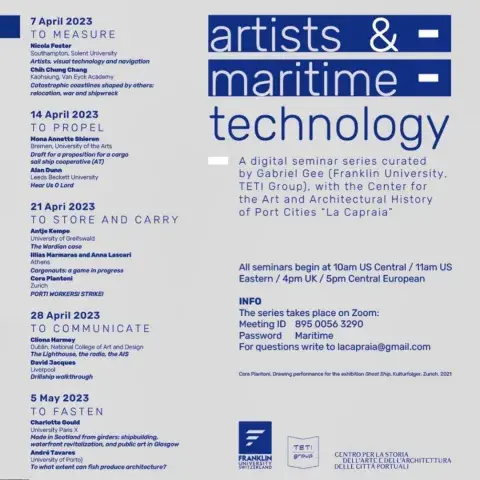
Professor Gabriel Gee (Franklin University, TETI Group), with the Center for the Art and Architectural History of Port Cities “La Capraia” curated a digital series of seminars entitled Artists and Maritime Technology.
Going out to sea was long a perilous affair. Whether to secure access to fishing grounds and trade routes, to satisfy curiosity about the distant and the unknown, or simply to enjoy a day out on the deck in choppy waters, maritime spaces required specialized skills and technologies. Cultured craftsmanship gave communities the means to travel through the uncertain undulating expanses. Through increasing political and cultural connections, and with the development of commerce across the globe, the ingenuity that informed modes of transportation was further applied to the design of ports, which served as coastal interfaces between land and sea. In this vein, maritime technologies have introduced new forms in land-based societies, ranging from communication methods to transportation of goods; on the other hand, maritime technologies have channeled new mechanical inventions designed for land purposes – for example, the steam engine – which are then applied to specific maritime necessities.
In relation to such technological activities, artists have occupied varied positions over time. Considered as visual and material producers and innovators, artists could take part in the development of maritime technology; as such our line of enquiry can focus on the role and understanding of craftsmanship, as well as the relation between art and science, in particular that of the mechanical arts – as known and theorized in Western culture, but more generally approached through physics and engineering in different geographical contexts. As providers of visual materials, artists were also mediators of technological progress, representing the changing nature of material maritime forms. Representation, though, must not be seen as mere passive duplication. The depictions of maritime infrastructure contributed first to its understanding, second to its critical discursive appropriation, which can in turn inform material processes. As agents of “imagination,” artists partake in a cognitive capture of the world, which can lead to its renewed invention. This research seminar on “artists and maritime technology” aims to bring together art historians and artists to consider past and present relations between artistic practices and maritime technology, which we see as a strategic nexus of historical and contemporary cultural transformation.
7 April 2023
To measure
Nicola Foster (Southampton, Solent University), Artists, visual technology and navigation
Chih Chung Chang (Kaohsiung, Van Eyck Academy), Catastrophic coastlines shaped by others: relocation, war and shipwreck
14 April 2023
To propel
Mona Annette Shieren (Bremen, University of the Arts), Draft for a proposition for a cargo sail ship cooperative (AT)
Alan Dunn (Leeds Beckett University), “Hear Us O Lord”
21 April 2023
To store and carry
Antje Kempe (University of Greifswald), The Wardian case
Illias Marmaras and Anna Lascari (Athens), Cargonauts: a game in progress
Cora Piantoni (Zurich), PORT! WORKERS! STRIKE!
28 April 2023
To communicate
Cliona Harmey (Dublin, National College of Art and Design), The Lighthouse, the radio, the AIS,
David Jacques (Liverpool), Drillship walkthrough
5 May 2023
To fasten
Charlotte Gould (University Paris X), Made in Scotland from girders: shipbuilding, waterfront revitalization, and public art in Glasgow
André Tavares (University of Porto), To what extent can fish produce architecture?
All seminars begin at 10am US Central / 11am US Eastern / 4pm UK / 5pm Central European
INFO
The series takes place on Zoom:
Meeting ID 895 0056 3290
Password Maritime
For questions, write to lacapraia@gmail.com

